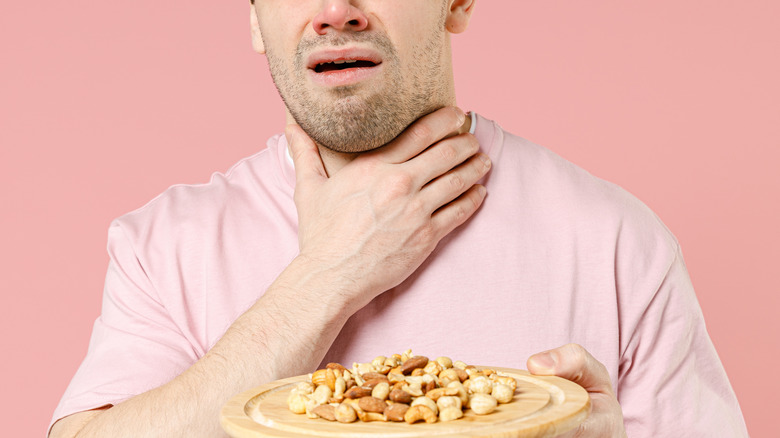Everything You Need To Know About Nut Allergies
For most people, eating out or going to parties is a fun and risk-free activity they get to enjoy with their family and friends. However, this may not always be the case for people with nut allergies. Since nuts are one of the eight most common allergenic foods that affect millions of Americans — along with milk, eggs, fish, crustacean shellfish, peanuts, wheat, and soybeans (vía the Food and Drug Administration, or FDA) — gatherings that center around food may be especially worrisome for adults and parents of children with nut allergies.
The Centers for Disease Control and Prevention (CDC) explains that a food allergy happens when your immune system mistakenly reacts to a food treating it as if it were harmful. Yet, while your body goes on to attack said food, it triggers a chain of harmful reactions in the process that lead to symptoms ranging from mild to severe. Some may even lead to life-threatening responses. For this reason, food allergies are classified as a food safety concern.
It's important to note that, despite being often mixed up, food allergies and food intolerances are two very different things, even if their symptoms are similar or they're caused by the same food. A 2020 review published in the International Journal of Molecular Sciences explains that, unlike food allergies, food intolerances are not an immune response.
Nut allergies defined
Nut allergy refers to the adverse reaction explicitly caused by the intake of tree nuts, which affects about 0.5–1% of Americans, typically starting during childhood. As their name implies, tree nuts grow on trees, and they include almonds, walnuts, Brazil nuts, hazelnuts, cashews, pecans, pine nuts, and pistachios (per the American Academy of Allergy, Asthma, and Immunology, or AAAAI).
According to the British Society for Allergy & Clinical Immunology (BSACI) guidelines published in the journal Clinical and Experimental Allergy, "nut allergies are an IgE-mediated reaction induced by nut proteins." This means that your body releases the antibody immunoglobulin E (IgE) to neutralize specific proteins in nuts that are typically harmless to other people. These proteins are called allergens, and when you consume them again, IgE antibodies react to them by releasing a set of chemicals that cause allergy symptoms (via the Mayo Clinic).
In addition, there's another type of IgE-mediated nut allergy called Pollen Food Syndrome (PFS), also known as Oral Allergy Syndrome. Per the BSACI guidelines, this type of allergy is characterized by seasonal allergic rhinitis and potential reactions to fresh fruit, vegetables, or nuts.
Common nut allergy symptoms
Food allergy symptoms are very varied. Therefore, people with the same allergy may not necessarily experience the same symptoms. However, common food allergy symptoms are generally the same among different allergies, and can be divided into mild and severe.
Mild symptoms include runny nose, skin redness, rashes, watery or itchy eyes, itchy lips, sore throat, sneezing, abdominal pain, nausea, and swelling of the lips. In contrast, severe symptoms include diarrhea, profuse vomiting, shortness of breath, throat tightening, and wheezing (per Midland Health).
Additionally, the BSACI guidelines explain that when it comes to IgE-mediated reactions, symptoms show within minutes after ingestion — which is why they're also known as rapid-onset symptoms — and that symptoms may vary depending on site of exposure and quantity. For instance, skin or cutaneous exposure rarely leads to severe symptoms. However, oral ingestion leads to immediate mild to severe symptoms. Similarly, while it is not a rule of thumb, consuming large amounts of tree nuts is associated with more severe reactions than consuming smaller quantities.
Risk factors of nut allergies
According to a 2018 review in F1000 Research, there are quite a few circumstances that may increase the chances of developing a nut allergy, including a family history of peanut allergy, personal history of egg allergy, and personal history of other allergic conditions such as atopic dermatitis, rhinitis, and eczema. Furthermore, the review states that risk factors for tree nut allergy are similar to those for peanut allergy, which include delayed oral exposure and early cutaneous exposure — meaning that either the nuts were not introduced to a kid's diet until later in life, or that despite not eating them, kids were exposed to nut products at a very young age.
Per another 2018 review in the Journal of Asthma and Allergy, nut allergies typically develop around two years of age. While being allergic to one tree nut doesn't mean you'll be allergic to all of them, it does increase the risk of developing a second allergy, as the number of tree nuts that a person reacts to can increase with age. In fact, it determined that the tree nut allergies that are more likely to coexist are cashew with pistachio and walnut with pecan.
Lastly, the Mayo Clinic explains that food allergies are more common in toddlers and infants because their digestive systems are not fully mature, meaning that they have higher chances of absorbing food components that trigger allergies. It also notes that the risk of suffering fatal symptoms seems to increase in people with asthma.
Peanut allergy and nut allergies are not the same
Unlike tree nuts, peanuts don't grow on trees. Instead, they grow underground, and thus, they are botanically considered a legume — like beans and lentils (per the AAAAI). Therefore, both allergies are not the same.
Nevertheless, peanut allergy and tree nut allergy are connected and share multiple similarities. For starters, according to a 2012 review published in the Journal of the American Academy of Dermatology, peanut allergy is also an IgE-mediated reaction to peanut proteins that can lead to a rapid onset of symptoms such as hives and skin swelling.
Furthermore, a 2018 review published in the Journal of Asthma and Allergy reports that coallergies between tree nuts and peanuts range between 20% and 68% of cases, because allergenic proteins in peanuts are very similar to allergenic proteins in tree nuts. Scientists found similar results in another review published in 2022 in Foods, stating that about 30% of people with peanut allergy have cross-reactivity with tree nuts.
Nut allergy diagnosis
Nut allergies are diagnosed just as any other food allergy. In fact, the tests are the same ones used to diagnose peanut allergies. According to the Cleveland Clinic, there are three standard food allergy testing options: oral food challenge, skin puncture tests, and blood tests.
Oral food challenges (OFC) and skin puncture tests are performed in an allergist's office (a doctor specializing in diagnosing and treating allergies). OFC consists of consuming small amounts of the suspected allergenic food and gradually increasing the dose until you start showing symptoms. If no symptoms occur, an allergy is ruled out. Skin puncture tests are designed to measure the presence of IgE antibodies to a suspected food. In this case, the doctor punctures or scratches the skin with a solution containing the allergen and examines whether you react to it or not. Positive tests show a small patch of red and itchy skin (vía Food Allergy Research and Education, or FARE).
Like SPT, blood tests also detect IgE specific to foods. While these may be a better option for people with extensive rashes that hinder the use of skin tests, blood tests tend to be less specific because they only indicate that there's a chance that there's an allergy, but don't predict its severity. Lastly, according to FARE, another helpful and inexpensive method to try along these tests is a food elimination diet, in which you temporarily eliminate a specific food from your diet while monitoring whether or not your symptoms disappear as well.
Nut allergy treatment
There's currently no cure for nut allergies. Therefore, treatment is centered on nut avoidance. While being allergic to one tree nut doesn't mean you'll be allergic to all of them, the BSACI guidelines explain that avoiding all nuts and even peanuts (unless you have a negative test) is the best way to reduce the risk of accidental reactions. Additionally, people with nut allergies should always carry oral antihistamines and an adrenaline auto-injector (AAI), commonly known as epinephrine auto-injector or EpiPen. Oral antihistamines help treat mild symptoms because they block histamine release — the chemical your immune system produces when it detects an allergen, which is responsible for allergies symptoms. In contrast, an AAI helps treat anaphylaxis episodes, an acute and fatal allergic reaction.
Complete nut avoidance may be challenging and become significantly restrictive. However, the AAAAI shares some helpful tips on how to live with nut allergies, including always asking about ingredients when eating at a restaurant or friend's house, carefully reading food labels (which should disclose whether a food contains nuts or was prepared in a facility that handles them), teaching family and friends how to use an AAI, and wearing a medical alert bracelet with your personal information and allergy status.
Furthermore, because nut allergies are more common in children and due to the high risk of accidental reactions, the CDC suggests developing plans to prevent and respond to food allergy emergencies in schools to avoid serious complications.
Foods to avoid
The list of nuts a person with a nut allergy should avoid can be pretty extensive, as tree nuts include almonds, walnuts, Brazil nuts, hazelnuts, cashews, pecans, pine nuts, pistachios, beechnuts, butternuts, shea nuts, pili nuts, Nangai nuts, macadamia nuts, lychee nuts, chestnuts, ginkgo nuts, and hickory nuts. Additionally, per FARE, other common and unexpected ingredients to avoid include nut extracts — although artificial extracts are usually safe — nut liqueurs, gianduja, marzipan, nut butters, flours, milks, paste, meals, and oils, pesto, and praline.
Furthermore, due to the risk of cross-contact in manufacturing facilities and restaurants (which is when nut allergens come in contact with a food that wouldn't typically contain nuts), FARE warns that tree nut allergens can also be found in cereals, cookies, candy, energy bars, dressings and sauces, bakeries, ice cream and coffee shops, and some cuisine-specific restaurants (such as Chinese, African, Indian, Thai, and Vietnamese). Lastly, depending on your allergy severity, you should also steer clear of beauty products containing nut oils such as walnut, almond, and argan oils, which can be found in lotions, soaps, shampoos, and other hair care products.
Nut allergy complications
According to the Mayo Clinic, two complications may occur when consuming allergenic foods: eczema (also known as atopic dermatitis) and anaphylaxis. Eczema is when patches of skin become red, itchy, and inflamed, which is a more extensive and uncontrolled version of what you'd experience with a skin puncture test. While it is very uncomfortable, it is not fatal, unlike anaphylaxis, which is considered a life-threatening reaction.
As explained by a 2011 review published in the World Allergy Organization Journal, anaphylaxis is a medical emergency that requires immediate attention. It is characterized by tightening of the airways, troubled breathing, wheezing, low blood pressure, swollen lips or tongue, abdominal pain or vomiting, and in some cases, loss of consciousness, which can appear within minutes of allergen exposure.
Given its severity, the review enlists a series of steps on how to manage it appropriately, starting with removing the exposure to the triggering food. Second, you should check the person's breathing and skin while simultaneously calling 911 or any available emergency medical service and injecting either 1 or 2 doses of epinephrine in the mid-thigh within 5 to 15 minutes apart. Third, lay the person down on their back or in another comfortable position in case of vomiting and raise their legs. Lastly, perform cardiopulmonary resuscitation (CPR) if needed.
Prevention ideology has changed
Once upon a time, it was believed that since during the first 1000 days of life — also known as the "window of opportunity" — the likelihood of developing allergies for each person is established, avoiding the introduction of potentially allergenic foods into the diet of children with higher allergy risk was key for allergy prevention, according to a review published in the International Journal of Molecular Sciences. However, scientific evidence now suggests that excluding food allergens may actually have the opposite effect, contributing to an increase in food allergies over time.
As such, the review explains that repeatedly providing children with allergenic foods such as nuts and peanuts during the first months of life may actually lead to protective immune responses. It also proposes that maternal intake of common food allergens during pregnancy may also be a useful allergy-reducing approach. For example, the Learning Early about Peanut Allergy (LEAP) trial shows that peanut consumption between 4 and 11 months of age in high allergy risk infants was associated with an 86% and a 70% allergy reduction at 5 years of age among those who had negative and positive skin puncture test results, respectively, compared to those with peanut avoidance. This suggests that the early introduction of food allergens to the diet is a potentially promising prevention strategy.
Little evidence shows you can become tolerant
Even though food allergies are very similar when it comes to diagnosis, symptoms, and treatment, they differ from one another in terms of resolution rates. As Nancy Ott, M.D. explains via the Mayo Clinic, whether or not a child outgrows their food allergy mostly depends on the food they're allergic to and the allergy's severity. Out of the eight most common food allergies, people with eggs, milk, wheat, and soy allergy are more likely to outgrow them or become tolerant during their late teens. Yet, this is not always the case for tree nuts, peanuts, fish, and crustacean shellfish — which also happen to be the ones that cause more severe allergic reactions.
Nevertheless, not all is lost for people with nut allergies. Per the AAAAI, about 10% of children with tree nut allergies may outgrow them throughout their lifetime, which can be confirmed through repeat allergy testing. Similarly, according to a 2018 study published in the journal Annals of Allergy, Asthma, and Immunology, while tree nut allergies tend to persist into adulthood, one study in 101 children with tree nut allergy reported that 9% regained tolerance based on an oral food challenge diagnosis. Likewise, a 2011 study in over 38,000 children published in the journal Pediatrics determined that 14% of those with self-reported tree nut allergy later reported tolerance.
Nut allergies typically start in childhood, though you could develop one as an adult
It is one thing to develop a nut allergy in childhood and have it persist throughout adulthood. Still, it is a whole other thing when you develop it as an adult.
According to a 2020 study published in The Journal of Allergy and Clinical Immunology, out of the 4.6 million Americans with peanut allergy, over 800,000 seem to have developed it after 18 years of age. Since peanut and tree nut allergies have so much in common, the study found that there's also a chance of developing adult-onset tree nut allergy, though to a much lesser extent.
While diagnosis and treatment for adult-onset allergies are the same as for childhood-onset allergies, adults seem to have more trouble getting a correct diagnosis compared to children, most likely because medical professionals are less inclined to look for food allergies in the adult population (via Healthline).












